Potřebujeme váš souhlas k využití jednotlivých dat, aby se vám mimo jiné mohly ukazovat informace týkající se vašich zájmů. Souhlas udělíte kliknutím na tlačítko „OK“.
ASTM D7046-11
Standard Guide for Use of the Metal Detection Method for Subsurface Exploration (Withdrawn 2020)
Automaticky přeložený název:
Standardní Příručka pro použití metody detekce kovů pro podpovrchových průzkum
NORMA vydána dne 1.5.2011
Informace o normě:
Označení normy: ASTM D7046-11
Poznámka: NEPLATNÁ
Datum vydání normy: 1.5.2011
Kód zboží: NS-37414
Počet stran: 8
Přibližná hmotnost: 24 g (0.05 liber)
Země: Americká technická norma
Kategorie: Technické normy ASTM
Kategorie - podobné normy:
Anotace textu normy ASTM D7046-11 :
Keywords:
frequency domain, geophysics, metal detection, metal detector, subsurface investigation, surface geophysics, time domain, Geophysical investigations/geophysics, Metal detection/metal detector, Subsurface investigation--soil/rock, ICS Number Code 13.080.99 (Other standards related to soil quality)
Doplňující informace
| Significance and Use | ||||||||||||||||||||||||||
|
Concepts: This guide summarizes the equipment, field procedures, and interpretation methods for using the metal detection method for locating subsurface metallic objects. Personnel requirements are as discussed in Practice D3740. Method—Metal detectors are electromagnetic instruments that work on the principle of induction, using typically two coils (antennas); a transmitter and a receiver. Both coils are fixed in respect to each other and are used near the surface of the earth. Either an alternating or a pulsed voltage is applied to the transmitter coil causing electrical eddy currents to be induced in the earth. The electrical currents flowing in the earth are proportional to electrical conductivity of the medium. Theses currents generate eddy currents in buried metallic objects that is detected and measured by the receiver (Fig. 1). Parameter Measured and Representative Values: Frequency Domain Metal Detectors: Frequency domain metal detectors apply an alternating current having a fixed frequency and amplitude to the transmit coil which generates a time-varying magnetic field around the coil. This field induces eddy currents in nearby metallic objects that in turn generate time-varying magnetic fields of their own. These eddy-fields induce a voltage in the receiver coil. The presence of metal causes small changes in the phase and amplitude of the receiver voltage. Most metal detectors amplify the differences in the receiver coil voltage caused by nearby metal and generate an audible sound or meter (analog or digital) reading. Ground conductivity meters (frequency domain metal detectors) measure the two-components of the secondary magnetic field simultaneously. The first is the quadrature-phase component which indicates soil electrical conductivity and is measured in millisiemens per meter (mS/m). The second is the inphase component, which is related to the subsurface magnetic susceptibility and is measured in parts per thousand (ppt) (that is, the ratio between the primary and secondary magnetic fields). (1) Conductivity Measurements (Quadrature-Phase Component)Metallic objects within a few feet of the surface will cause induced magnetic field distortions that will result in zero or even negative values of measured conductivity. Deeper metallic objects will cause less field distortion and lead to measured conductivities which are abnormally high in comparison to site background values. (2) Inphase ComponentInphase measurements are more sensitive to metal than conductivity measurements. Thus, inphase anomalies may indicate the presence of metal at a greater depth than the conductivity measurements. Time Domain Metal Detectors: In time domain metal detectors, a transmitter generates a pulsed primary magnetic field in the earth. After each pulse, secondary magnetic fields are induced briefly from moderately conductive earth, and for a longer time from metallic targets. Between each pulse, the metal detector waits until the response from the conductive earth dissipates, and then measures the prolonged buried metal response. This response is measured in millivolts (mV). Equipment—Metal detectors generally consist of transmitter electronics and transmitter coil, power supply, receiver electronics and receiver coil. Metal detectors are usually single individual portable. Typical “treasure-hunter” metal detectors provide an audible signal and/or meter reading (analog or digital) when metal is detected. Quadrature and inphase measurements from ground conductivity meters are shown either on analog or digital meters. These measurements can often be recorded digitally in the field using a small field recorder, strip-chart recorder, or computer. Time domain metal detectors can consist of either one or two receiver coils. When two coils are used, one coil is typically placed above the other. Readings from both coils are recorded simultaneously. In order to improve detection of deeper metallic targets, the differential response from the two receiver coils can be used to suppress the response from smaller, shallower metallic targets. Some time domain metal detectors are mounted on wheels, allowing for the use of odometers to provide location data. Limitations and Interferences: General Limitations Inherent to Geophysical Methods: A fundamental limitation of all geophysical methods is that a given set of data cannot be associated with a unique set of subsurface conditions. In most situations, surface geophysical measurements alone cannot resolve all ambiguities, and some additional information, such as borehole data, is advised. Because of this inherent limitation in the geophysical methods, a metal detector survey alone can never be considered a complete assessment of subsurface conditions. Properly integrated with other geologic information, metal detector surveying is a highly effective method of obtaining subsurface information. In addition, all surface geophysical methods are inherently limited by decreasing resolution with depth. Limitations Specific to the Metal Detection Method: Several factors influence metal detector response: the properties of the target, the properties of the soil/rock, and the characteristics of the metal detector itself. The target’s size, depth, and condition of burial are the three most important factors. The larger the surface area of the target, the greater the eddy current that may be induced, and the greater the depth at which the target may be detected. The metal detector’s response decreases at a rate equal to the reciprocal of its depth up to the sixth power (1/depth6). Therefore, if the distance to the target is doubled, the metal detector response will decrease by a factor of 64. Consequently, the metal detector is a relatively shallow-depth device. It is generally restricted to detecting small objects at relatively shallow depths or larger targets at limited depths. Generally, most metal detectors are incapable of responding to targets at depths much greater than 6 m. Although the shape, orientation, and composition of a target will influence the metal detector response, these factors will have much less influence than will the size and depth of the target. Target deterioration, however, has a significant impact. Metallic containers will corrode in natural soils conditions. If a container is corroded, its surface area will be significantly reduced, and in turn will degrade the response of a metal detector. Because the metal detector’s response weakens rapidly with increasing distance to the target, system gain and instrument stability are important. The size of the coil controls the size and depth of the metallic target that can be detected as shown in Fig. 2. Interferences Caused by Natural and Cultural Conditions: Sources of noise referred here do not include those of a physical nature such as difficult terrain or man-made obstructions but rather those of a geologic, ambient, or cultural nature that can adversely affect the measurements and hence the interpretation. Natural Sources of Noise—Some kinds of soil/rock, particularly those containing high iron content (often known as mineralized soil) affect receiver coil output strongly enough to indicate the presence of a metal target with certain kinds of metal detectors. Some types of metal detectors provide a means for compensating the output for the ground effect. This usually requires the operator to position the detector near the ground (but not near a metal target) and adjust a control until the target signal disappears. Small variations in the soil characteristics and stones (particularly those containing metallic compounds) can cause small changes in the detector output. Often these changes cause small target-like signals, known as “ground noise.” These can confuse the operator because they sound like small targets. Cultural Sources of Noise—Cultural sources of noise can include interference from electrical power lines, communications equipment, nearby buildings, and metal fences. Interference from power lines is inversely proportional to the distance between power line and detector; therefore most metal detectors with small coils are generally unaffected. Surveys should not be made in close proximity to buildings, metal fences or buried metal pipe lines that can be detected by the metal detection method, unless detection of the buried pipe line, for example, is the object of the survey. It is sometimes difficult to predict the appropriate distance from the potential sources of noise. Measurements made on-site can quickly yield the magnitude of the problem, and adjustments can then be made. Precaution must also be taken to remove metal from the operator, or to minimize its effects. Steel-toe boots, respirators, and air bottles can all cause considerable problems with noise. Summary—During the course of designing and carrying out a metal detection survey, the sources of ambient, geologic and cultural noise must be considered and the time of occurrence and location noted. The exact form of the interference is not always predictable, as it not only depends upon the type of noise and the magnitude of the noise but also upon the distance from the source of noise and possibly the time of day. |
||||||||||||||||||||||||||
| 1. Scope | ||||||||||||||||||||||||||
|
1.1 Purpose and Application—This guide summarizes the equipment, field procedures, and interpretation methods for the assessment of subsurface materials using the metal detection method. Metal detectors respond to the presence of both ferrous and nonferrous metals by inducing eddy currents in conductive objects. Metal detectors are either frequency domain (continuous frequency or wave) or time domain (pulsed) systems. A wide range of metal detectors is commonly available. 1.1.1 Metal detectors can detect any kind of metallic material, including both ferrous metals such as iron and steel, and non-ferrous metals such as aluminum and copper. In contrast, magnetometers only detect ferrous metals. 1.1.2 Metal detector measurements can be used to detect the presence of buried metal trash, drums (Tyagi et al, 1983) (1) and tanks, abandoned wells (Guide D6285); to trace buried utilities; and to delineate the boundaries of landfill metal and trench metal. They are also used to detect metal based unexploded ordnance (UXO). 1.2 Limitations: 1.2.1 This guide provides an overview of the metal detection method. This guide does not provide or address the details of the theory, field procedures, or interpretation of the data. References are included for that purpose and are considered an essential part of this guide. It is recommended that the user of this guide be familiar with the references cited and with the ASTM standards D420, D653, D5088, D5608, D5730, D5753, D6235, D6429, and D6431. 1.2.2 This guide is limited to metal detection measurements made on land. The metal detection method can be adapted for a number of special uses on land, water, airborne and ice. 1.2.3 The approaches suggested in this guide for the metal detection method are commonly used, widely accepted, and proven. However, other approaches or modifications to the metal detection method that are technically sound may be substituted. 1.2.4 This guide offers an organized collection of information or a series of options and does not recommend a specific course of action. This document cannot replace education or experience and should be used in conjunction with professional judgment. Not all aspects of this guide may be applicable in all circumstances. This ASTM standard is not intended to represent or replace the standard of care by which the adequacy of a given professional service must be judged, nor should this document be applied without consideration of a project’s many unique aspects. The word “Standard” in the title of this document means only that the document has been approved through the ASTM consensus process. 1.3 The values stated in SI units are regarded as standard. The values given in parentheses are inch-pound units, which are provided for information only and are not considered standard. 1.4 Precautions: 1.4.1 It is the responsibility of the user of this guide to follow any precautions in the equipment manufacturer's recommendations and to establish appropriate health and safety practices. 1.4.2 If the method is used at sites with hazardous materials, operations, or equipment, it is the responsibility of the user of this guide to establish appropriate safety and health practices and to determine the applicability of any regulations prior to use. 1.4.3 This standard does not purport to address all of the safety concerns, if any, associated with its use. It is the responsibility of the user of this standard to establish appropriate safety and health practices and determine the applicability of regulatory requirements prior to use. |
||||||||||||||||||||||||||
| 2. Referenced Documents | ||||||||||||||||||||||||||
|
Podobné normy:
Historická
1.12.2011
Historická
1.11.2009
Historická
1.8.2013
Historická
15.1.2013
Historická
1.5.2014
Historická
1.9.2012
Doporučujeme:
Aktualizace zákonů
Chcete mít jistotu o platnosti užívaných předpisů?
Nabízíme Vám řešení, abyste mohli používat stále platné (aktuální) legislativní předpisy.
Chcete vědět více informací? Podívejte se na tuto stránku.



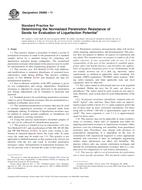 ASTM D6066-11
ASTM D6066-11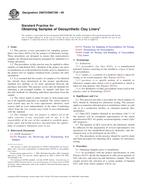 ASTM D6072/D6072M-09..
ASTM D6072/D6072M-09..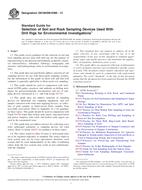 ASTM D6169/D6169M-13..
ASTM D6169/D6169M-13..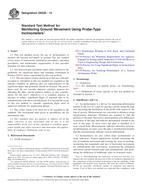 ASTM D6230-13
ASTM D6230-13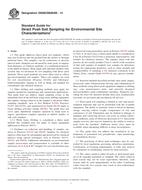 ASTM D6282/D6282M-14..
ASTM D6282/D6282M-14.. ASTM D6286-12
ASTM D6286-12
 Cookies
Cookies
